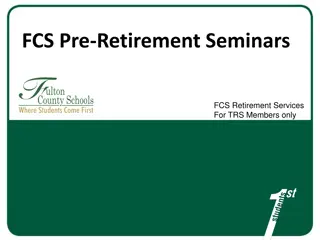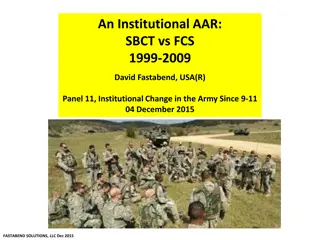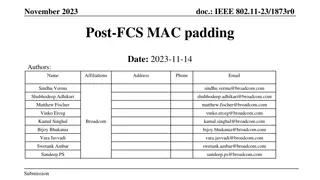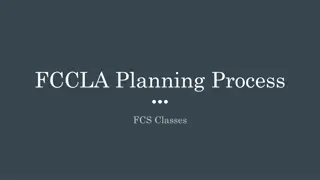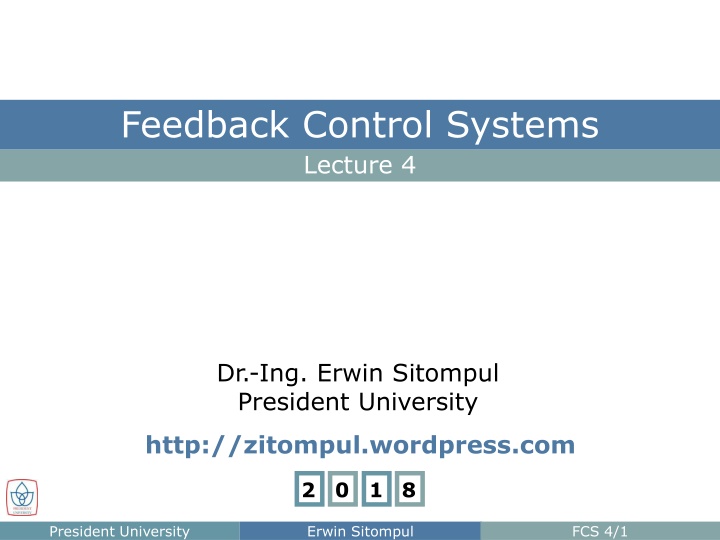
Feedback Control Systems: Understanding Specifications and Equations
Explore the fundamental concepts of feedback control systems, including analysis of static and dynamic requirements, open-loop and closed-loop control equations, and key transfer functions. Learn how to address steady-state and transient responses while maintaining stability in control systems.
Download Presentation

Please find below an Image/Link to download the presentation.
The content on the website is provided AS IS for your information and personal use only. It may not be sold, licensed, or shared on other websites without obtaining consent from the author. If you encounter any issues during the download, it is possible that the publisher has removed the file from their server.
You are allowed to download the files provided on this website for personal or commercial use, subject to the condition that they are used lawfully. All files are the property of their respective owners.
The content on the website is provided AS IS for your information and personal use only. It may not be sold, licensed, or shared on other websites without obtaining consent from the author.
E N D
Presentation Transcript
Feedback Control Systems Lecture 4 Dr.-Ing. Erwin Sitompul President University http://zitompul.wordpress.com 2 0 1 8 President University Erwin Sitompul FCS 4/1
Feedback Control Systems Chapter 4 A First Analysis of Feedback President University Erwin Sitompul FCS 4/2
Chapter 4 A First Analysis of Feedback Control Specifications While maintaining the essential property of stability, the control specifications include both static and dynamic requirements such as the following: Steady-state response, static properties The permissible steady-state error while performing regulation in the presence of constant (= bias ) disturbance signal and sensor noise The permissible steady-state error while tracking a polynomial reference signal such as a step or a ramp The sensitivity of the system transfer function to changes in model/plant parameters The permissible transient error in response to a step in either the reference or the disturbance input Transient response, dynamic properties President University Erwin Sitompul FCS 4/3
Chapter 4 A First Analysis of Feedback The Basic Equations of Control Open-loop control system can be given as: The output is given by: = + Y GD R GW W : Disturbance, taken to be at the input of the plant ol ol The error, the difference between reference input and system output, is given by: = R Y = + = 1 GD R GW E R GD R GW ol ol ol ol = T GD Tol: Open-loop transfer function ol ol = R GW 1 E T ol ol President University Erwin Sitompul FCS 4/4
Chapter 4 A First Analysis of Feedback The Basic Equations of Control Closed-loop control system can be given as: V : Sensor noise, taken to be at the input of the sensor The equation of output and the control are given by: GD GD + GD GD + G GD = + cl cl Y R W V cl + 1 1 1 cl cl cl D GD + GD GD + D GD + = cl cl cl U R W V 1 1 1 cl cl cl President University Erwin Sitompul FCS 4/5
Chapter 4 A First Analysis of Feedback The Basic Equations of Control The equation of error is, Ecl=R Ycl, is given by: GD G E R R GD GD + + = + + + GD GD + = + cl cl W V cl 1 1 1 cl cl cl 1 GD GD GD + G GD cl E R W V cl 1 1 1 cl cl cl In this case, the closed-loop transfer function is: GD T GD + = cl cl 1 cl With equations of T and E, for each open loop case (Tol, Eol) and closed-loop case (Tcl, Ecl), the four basic objectives of stability, tracking, regulation, and sensitivity will be explored. President University Erwin Sitompul FCS 4/6
Chapter 4 A First Analysis of Feedback Stability We now write the controller and the plant as quotients of polynomials such as: ( ) ( ) , ( ) a s d s ( ) ( ) c s b s = = ( ) s ol or cl D G s For open loop system, the transfer function is: T GD = ( ) ( ) ( ) ( ) a s d s ol ol b s c s = The characteristic equation (denominator of the transfer function) is a(s) d(s). Neither a(s) nor d(s) may have roots in the RHP. President University Erwin Sitompul FCS 4/7
Chapter 4 A First Analysis of Feedback Stability An attempt to cancel unstable roots of a(s) of the plant by using c(s) of the controller will be useless. Although cancelled, physically the unstable pole still remains. Slightest noise or disturbance will cause the output to grow divergently. An attempt to cancel zero of b(s) in the RHP that causes undershoot by using d(s) of the controller is out of question. Since to cancel RHP zero, an RHP pole must be placed in d(s) and will similarly result in unstable system. Conclusion: Open loop structure cannot make an unstable plant to be stable. Therefore, open loop structure can only be used if the plant is stable. President University Erwin Sitompul FCS 4/8
Chapter 4 A First Analysis of Feedback Stability For closed-loop system, the transfer function is: ( ) ( ) ( ) ( ) ( ) 1 ( ) a s d s b s c s a s d s b s c s + GD GD + ( ) ( ) ( ) b s c s + = = = cl T cl 1 ( ) ( ) a s d s ( ) ( ) b s c s cl ( ) The characteristic equation is now a(s) d(s)+b(s) c(s). Still, pole cancellation will not work. Because if RHP pole of a(s) should be canceled by using c(s), the pole will become a factor in the characteristic equation. The system will be sensitive to noise or disturbance. But, the closed-loop structure clearly grants more freedom in controller design. Having a pole of a(s) in the RHP does not prevent the design of controller that will make the system stable. President University Erwin Sitompul FCS 4/9
Chapter 4 A First Analysis of Feedback Tracking: Following the Reference Input Tracking problem is to cause the output to follow the reference input as closely as possible. For the special case, where only R is the input to the system, the ability of the system to track a reference can be compared. For open-loop control: = = Y GD R T R R is said to be perfectly tracked if E is zero In open-loop control, Dol cannot be freely chosen so that the error Eol is zero In closed-loop control, Dcl can be chosen to be arbitrarily large so that Ecl approaches zero ol ol ol = 1 E T R ol ol For closed-loop control: GD GD + 1 = cl Y R = T R cl 1 cl cl = E T R cl cl President University Erwin Sitompul FCS 4/10
Chapter 4 A First Analysis of Feedback Regulation: Disturbance Rejection Regulation problem is to keep the error small when the reference is at most a constant set point and disturbances are present. Suppose that disturbance W interacts with applied input R. Now, compare open-loop control with feedback control on how well each system maintains a constant steady-state reference output in the face of external disturbance. = + Y GD R GW Disturbance directly affect the output ol ol GD GD + G GD = + Disturbance can be substantially reduced by assigning Dclproperly cl Y R W cl + 1 1 cl cl President University Erwin Sitompul FCS 4/11
Chapter 4 A First Analysis of Feedback Regulation: Sensor Noise Attenuation This only applies for closed-loop control, where sensor noise V is defined as GD GD Y R V GD GD + + 1 1 1 GD GD + + = cl cl cl 1 1 cl cl GD = + cl E R V cl cl cl To reduce steady-state error contributed by the transfer function of R, Dcl is selected to be large But, if Dcl is large, the transfer function of noise V tends to unity and the sensor noise is not reduced at all Resolution: Frequency separation between reference R and disturbance W (very low frequency content)and sensor noise V (mostly high frequencies) Each of R and V is a function of frequency, but with different frequency content President University Erwin Sitompul FCS 4/12
Chapter 4 A First Analysis of Feedback Sensitivity The parameter changes may be caused by external factors from the surroundings such as temperature, pressure, etc. Internal factors may also contribute to parameter changes, in the form of imperfections in the system components such as static friction, amplifier drift, aging, deterioration, etc. President University Erwin Sitompul FCS 4/13
Chapter 4 A First Analysis of Feedback Sensitivity Suppose that parameter changes happen in an operation, and make the gain of the plant G differs from its original value to G+ G. As the result, the overall transfer function of the system T will also change to to T+ T, and in time cause the change of system gain. By definition, the sensitivity of system gain T with respect to the plant gain G is given by: T G T T G T G G = = T G S President University Erwin Sitompul FCS 4/14
Chapter 4 A First Analysis of Feedback Sensitivity For the ideal case, only R is the input to the system, the original system gain T can be calculated. We set the frequency at zero to calculate the gain. For open-loop control: Y R = = = ol T GD Y GD R ol ol ol ol With the perturbed (disturbed) plant gain, the overall gain would be: ol( ) T T D G G + = + D G D G = + ol ol ol ol . = T D G Or: ol ol President University Erwin Sitompul FCS 4/15
Chapter 4 A First Analysis of Feedback Sensitivity Returning back to the sensitivity equation, T G T G ( ( ) GD G = T G S ol ol ) D G G = = T G S ol 1 ol T G G Or: = ol T ol . This means, in open loop system, the change of x% in G would yield exactly the same x% change in Tol. President University Erwin Sitompul FCS 4/16
Chapter 4 A First Analysis of Feedback Sensitivity For closed-loop control: GD GD + Y R GD GD + = = = cl Y R cl cl T cl cl 1 1 + (1 ) T G D D G D D G cl T G G GD GD + 1 1 GD + cl = cl cl cl + cl 2 cl (1 ) D G G T cl = T G S cl D D G = cl + 2 (1 ) cl cl D GD = cl + 2 (1 ) cl cl 1 T cl G T T T G G = = = T G S T G S G . cl 1 GD T G G = cl Or: + 1 T cl cl President University Erwin Sitompul FCS 4/17
Chapter 4 A First Analysis of Feedback Sensitivity The fractional change of the overall gain can be reduced by properly assigning Dcl to make the sensitivity low enough. In closed-loop control, the change in overall transfer function gain is less sensitive to variations in the plant gain compared to the change in open loop control. T G G 1 GD T G G = = ol cl + T 1 T ol cl cl President University Erwin Sitompul FCS 4/18
Chapter 4 A First Analysis of Feedback Advantages of Feedback Control + The permissible steady-state error in the presence of a constant disturbance signal ( bias ) can be reduced. + The permissible steady-state error while tracking a polynomial reference signal such as a step or a ramp can be reduced. + The sensitivity of the system transfer function to changes in model/plant parameters can be reduced. + The transient response can be speeded up to maintain permissible transient error in response to a step in either the reference or the disturbance input. + Unstable plants can be stabilized. President University Erwin Sitompul FCS 4/19
Chapter 4 A First Analysis of Feedback Disadvantages of Feedback Control Feedback control requires a sensor that can be very expensive and may introduce additional noise. Feedback control systems are often more difficult to design and to operate than open-loop systems. Feedback changes the dynamic response and often makes a system both faster and less stable. If everything seems under control, you re just not going fast enough (Mario Andretti, American racing driver). President University Erwin Sitompul FCS 4/20
Chapter 4 A First Analysis of Feedback System Type In the previous study we assumed both reference and disturbance to be constants, and also D(0) and G(0) to be finite constants. In this section, we will consider the possibility that either or both of D(s) and G(s) have poles at s=0. An example for D(s) is the well-known structure for the control equation of the form: ( ) dt de t k e = + ( ) + ( ) ( ) u t k e t d k p i d t = ( ) ( ) ( ), D s E s U s With we can deduct the corresponding transfer function k s = + + Proportional Integral Derivative (PID) control ( ) i D s k k s p d President University Erwin Sitompul FCS 4/21
Chapter 4 A First Analysis of Feedback System Type To accommodate various inputs that may be fed to a control system, the polynomial inputs of different degrees will now be fed to the system and the resulting steady-state tracking errors will be evaluated. A stable system can be classified as a type ksystem, with k defined to be the degree of the input polynomial for which the steady-state system error is a nonzero finite constant. Stable systems are classified into types according to the degree of the polynomial that they can reasonably track. For example, a system that can track a polynomial of degree 1 with a constant error is called Type 1. President University Erwin Sitompul FCS 4/22
Chapter 4 A First Analysis of Feedback System Type: Unity Feedback Case 1 GD GD GD + G GD = + cl E R W V + + 1 1 1 cl cl cl If we consider only the reference input R alone, set W=V=0, 1 1 GD + = = S E R R cl President University Erwin Sitompul FCS 4/23
Chapter 4 A First Analysis of Feedback System Type: Unity Feedback Case To consider polynomial inputs, let L 1 k kt k = = ( ) R s ( ) r t 1( ) t + 1 s ! k = k = k = 1 2 0 ( ) r t 1( ) t ( ) p t 1 1 1 1 t t t step input ( position input) ramp input ( velocity input) parabola input ( acceleration input) President University Erwin Sitompul FCS 4/24
Chapter 4 A First Analysis of Feedback System Type: Unity Feedback Case Applying the Final Value Theorem, lim ( ) t = = s E s 1 GD + 1 GD s + lim s ( ) e t e ss 0 = lim s ( ) s R s 1 0 cl 1 k = lim s s + 1 1 0 cl We consider first a system for which GDcl has no pole at the origin. For this system, only step input, R(s)=1/s (or k=0), will guarantee that the system error is a nonzero finite constant. 1 1 lim 1 GD s + cl 1 GD + 1 = = = cl(0) K Position error constant GD e s Type 0 p ss (0) 0 s cl Nonzero & finite President University Erwin Sitompul FCS 4/25
Chapter 4 A First Analysis of Feedback System Type: Unity Feedback Case For general expression of the steady-state errors, we collect all terms except the pole(s) at the origin into a function GDcl0(s) cl0 cl ( ) n GD s s and define K GD = ( ) s GD GDcl0 (s) is finite at s = 0 = 00 = 1 01 = 0 02= 0, cl0(0) n Substituting this expression to calculate the steady-state error, 1 1 lim ( ) 1 n s 1 lim ( ) s GD s s + = e s ss GD s s + 1 k 0 s If n > k, then ess = 0 If n < k, then ess If n = k, then ess is nonzero finite n = k =0, ess = 1/(1+Kp) n = k 0, ess = 1/Kn + cl0 n s = n k 0 s cl0 President University Erwin Sitompul FCS 4/26
Chapter 4 A First Analysis of Feedback System Type: Unity Feedback Case A unity feedback system is defined to be of type k if 1 s e = = 0 ( ) R s for ss k 1 k = 0 e ( ) R s for ss + 1 s For type 0 system, the error constant Kp, position constant, is given by = = lim s ( ), 0 K GD s n cl p 0 For type 1 system, the error constant Kv, velocity constant, is given by = s GD s = lim s ( ), 1 K n cl v 0 For type 2 system, the error constant Ka, acceleration constant, is given by = s GD s = 2 lim s ( ), 2 K n cl a 0 President University Erwin Sitompul FCS 4/27
Chapter 4 A First Analysis of Feedback System Type: Unity Feedback Case The higher the constant, the smaller the steady-state error President University Erwin Sitompul FCS 4/28
Chapter 4 A First Analysis of Feedback System Type: Unity Feedback Case Classifying a system as type k indicates the ability of the system to achieve zero steady-state error to any polynomial input r(t) of degree lessthan k. The system is of type k if the steady-state error is zero to all polynomials r(t) of degree less than k, nonzero finite for all polynomial of degree k, and infinite for all polynomial of degree more than k. President University Erwin Sitompul FCS 4/29
Chapter 4 A First Analysis of Feedback System Type: Unity Feedback Case Example: A temperature control system is found to have zero steady- state error to a constant tracking input and a steady-state error of 0.5 C to a ramp tracking input, rising at the rate of 40 C/s. ( ) C r t What is the system type? Finite error of ess a ramp tracking input Type 1 40 =0.5 C to 1 t s What is the error constant? For type 1, ess = 1/Kv for unit ramp input for the input in this example ess = 40/Kv Kv = 40/ess = 80 s 1 President University Erwin Sitompul FCS 4/30
Chapter 4 A First Analysis of Feedback System Type: Unity Feedback Case Example: Determine the system type and the relevant error constant for the speed-control with unity feedback and PI-control, if the plant transfer function is G=A/( s+1) and the controller transfer function is D=kp +ki/s. System type? G(s) D(s) = A(kps + ki)/{s( s+1)} One pole at origin Type 1 Error constant? For type 1, Kv = lim s G(s) D(s) s 0 = Aki Try to check using Final Value Theorem, ess=1/Kv President University Erwin Sitompul FCS 4/31
Chapter 4 A First Analysis of Feedback System Type: Unity Feedback Case Example: Find the steady-state error in terms of K and Kt when the system above are subjected to a unit step and a unit ramp function. Type 1 President University Erwin Sitompul FCS 4/32
Chapter 4 A First Analysis of Feedback System Type: Unity Feedback Case 1st Way = ( ) ( ) ( ) E s R s Y s 100 K K = ( ) ( ) R s R s ( ) + + + 2 4 100 1 20 100 s s K t + + 2 4 + (100 K 1)20 s + s K s = ( ) t R s + 2 4 (100 1)20 100 s K t President University Erwin Sitompul FCS 4/33
Chapter 4 A First Analysis of Feedback System Type: Unity Feedback Case The steady-state error for unit step input R(s)=1/s: + + 2 4 + (100 K 1)20 s + 1 s s K s = s E s = lim s ( ) lim s t e s ss + 2 4 (100 1)20 100 s K 0 0 t 0 The steady-state error for unit ramp input R(s)=1/s2: + + 2 4 + (100 K 1)20 s + 1 s s K s = s E s = lim s ( ) lim s t e s ss + 2 2 4 (100 1)20 100 s K 0 0 t + (100 1)20 K 1 + t K = 100 K K 100 t 5 President University Erwin Sitompul FCS 4/34
Chapter 4 A First Analysis of Feedback System Type: Unity Feedback Case 2nd Way 1 pole at the origin owned by G(s) D(s) System type: Type 1 Steady-state error for a unit step input: e = 0 100 s + K ss = ( ) ( ) G s D s cl + 20 (0.2 s 100 1) Kt Steady-state error for a unit ramp input: 1 ss v K = s G s D s lim s ( ) ( ) 100 s + K + 100 1 K K cl v = = e t 0 K 5 = lim s s + 20 (0.2 s 100 1) K 0 t 5 K K = + 100 1 t President University Erwin Sitompul FCS 4/35
Chapter 4 A First Analysis of Feedback Homework 4 (1/2) No.1.a For a plant having the transfer function 1/(s2+3s+9), it is proposed to use a controller in a unity feedback system and having the transfer function (c2s2+c1s+c0)/(s2+d1s). Solve for the parameters of this controller {c0,c1,c2,d1} so that the closed-loop will have the characteristic equation (s+6)(s+3)(s2+3s+9). No.1.b Show that if the reference input to the system of the above problem is a step of amplitude A, then steady-state error will be zero. Hint: Error is the difference between the desired output and the actual one. Steady-state error is an error that still persists in steady-state condition, at t . No.2, see next slide. President University Erwin Sitompul FCS 4/36
Chapter 4 A First Analysis of Feedback Homework 4 (2/2) No.2, FPE (6th Ed.), 4.20. Deadline: Wednesday, 10 October 2018. President University Erwin Sitompul FCS 4/37

